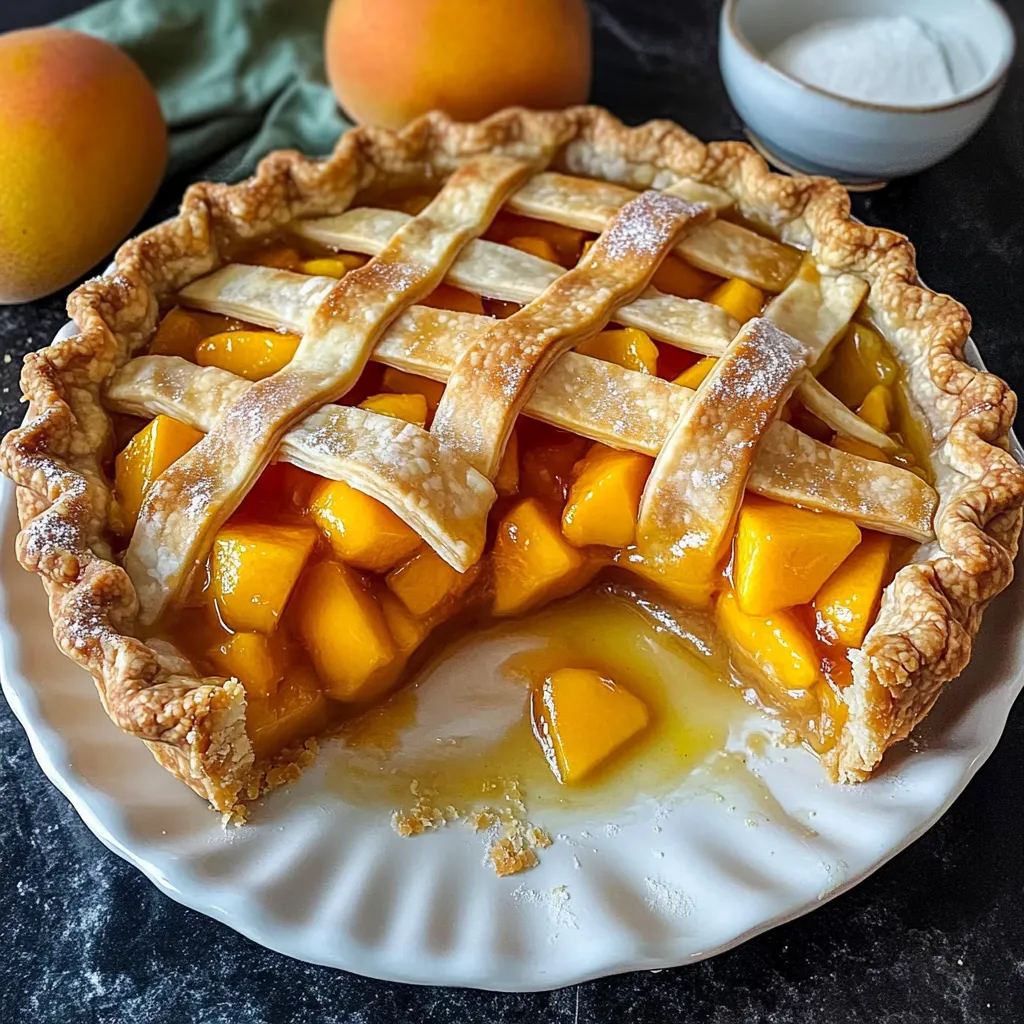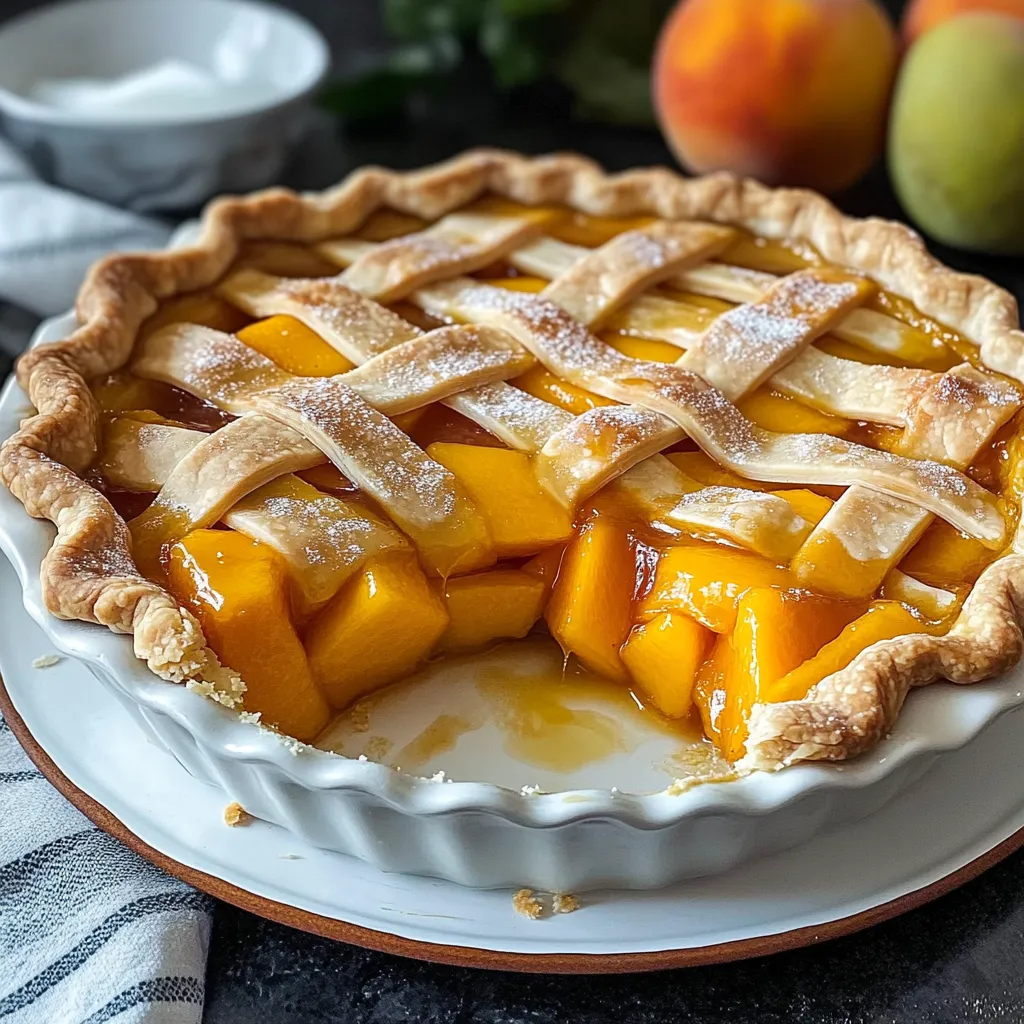 Bookmark
Bookmark
This classic Filipino-inspired Peach Mango Pie brings together two juicy fruits in a flaky, golden crust that will transport your taste buds straight to the tropics. The sweet mangoes paired with tangy peaches create a harmony of flavors that's both comforting and refreshing.
I first made this pie when I was missing the flavors of a Filipino fast food chain's famous peach mango pie. After perfecting this homemade version, my family now requests it for every summer gathering.
Ingredients
- Fresh peaches bring a slightly tart flavor that balances the sweetness of the mangoes. Look for firm but slightly yielding fruits
- Ripe mangoes add tropical sweetness and should have a slight give when gently squeezed
- Lemon juice brightens the filling and prevents browning of the fruits
- Sugar enhances the natural sweetness of the fruits. Use less if your fruits are particularly ripe
- Vanilla extract adds depth and warmth to the fruit filling
- Cornstarch thickens the filling perfectly so you avoid a soggy bottom crust
- Pie crust provides the flaky vessel for your filling. Store bought works well, but homemade adds extra flavor
- Egg wash gives the top crust that beautiful golden shine during baking
- Coconut sugar adds a caramelized finish and subtle tropical note to the crust
Step-by-Step Instructions
- Prepare the fruits
- Carefully peel and dice both peaches and mangoes into small cubes about half an inch in size. The uniform size ensures even cooking and a pleasant texture in every bite.
- Cook the filling
- Combine the diced fruits in a medium saucepan over medium heat with lemon juice, sugar, and a pinch of salt. Stir gently but frequently to prevent scorching. Let the mixture simmer for about 5 minutes until the fruits soften and release their natural juices.
- Thicken the mixture
- Once your fruits have released their juices, sprinkle the cornstarch over the mixture while stirring constantly to prevent lumps. Continue cooking for 2 to 3 minutes until the filling thickens noticeably and coats the back of a spoon. Remove from heat and stir in vanilla extract. Allow to cool completely before using.
- Roll the bottom crust
- On a lightly floured surface, roll out one portion of your pie dough into a circle about 12 inches in diameter and about 1/8 inch thick. Carefully transfer to your buttered pie pan, gently pressing into the corners without stretching the dough. Trim any excess dough, leaving about half an inch overhang.
- Add the filling
- Pour your cooled peach mango filling into the prepared crust, spreading it evenly with a spatula. Avoid overfilling as this can cause the pie to bubble over during baking.
- Create the lattice top
- Roll out the second portion of dough to the same thickness. Cut into even strips about half inch to three quarters inch wide. Arrange half the strips vertically across the pie with even spacing. Fold back alternating strips and place a horizontal strip across. Return the folded strips to their original position. Continue weaving until the lattice is complete.
- Seal and finish the edges
- Trim the lattice strips to match the bottom crust overhang. Fold the overhang under itself and press to seal, then crimp or flute the edges for a decorative finish. The sealed edge prevents filling from leaking during baking.
- Brush and bake
- Whisk together one egg with a teaspoon of water to create an egg wash. Brush this mixture generously over the lattice top and edges. Sprinkle with coconut or white sugar for extra crunch and shine. Bake in a preheated 350°F oven for 25 to 30 minutes until the crust is deeply golden brown.
 Bookmark
Bookmark
The mangoes are truly the star of this recipe. I discovered that using Ataulfo or Manila mangoes specifically gives the most authentic Filipino flavor profile. My grandmother always says the secret is getting mangoes that are just ripe but not too soft.
Selecting the Perfect Fruits
When choosing peaches for this pie, look for fruits that yield slightly to gentle pressure but aren't mushy. They should have a sweet aroma at the stem end. For the best flavor, use yellow peaches rather than white varieties as they hold up better during baking and provide a more robust flavor that stands up to the mangoes.
Mangoes should be fragrant and give slightly when pressed. The Ataulfo variety (sometimes called honey or champagne mangoes) works wonderfully in this recipe due to their creamy texture and intense sweetness. If those aren't available, Kent or Tommy Atkins mangoes make good substitutes, though you might want to add a touch more sugar if they're less sweet.
Make Ahead Options
This pie is perfect for preparing components in advance. The filling can be made up to three days before and stored in an airtight container in the refrigerator. This not only saves time on baking day but actually improves the flavor as it allows the fruits to meld together.
The entire unbaked pie can be assembled and frozen for up to a month. When ready to bake, don't thaw first – simply add about 15 minutes to the baking time, covering the edges with foil if they start to brown too quickly. This makes it perfect for preparing ahead for special occasions or unexpected guests.
Serving Suggestions
While delicious on its own, this Peach Mango Pie reaches new heights when served with complementary accompaniments. A scoop of vanilla ice cream creates a hot and cold contrast that's absolutely divine. For a tropical twist, try coconut ice cream or a dollop of lightly sweetened whipped cream with a sprinkle of toasted coconut.
For a truly Filipino experience, serve the pie slightly warm with a cup of strong coffee or hot chocolate. The bitter notes from the beverages balance beautifully with the sweet fruity filling. If serving for breakfast (I won't tell!), a side of tangy Greek yogurt makes it almost virtuous.
Recipe FAQs
- → Can I use canned peaches and mangoes for this pie?
Yes, you can substitute canned fruits, but drain them well first and reduce the sugar slightly as canned fruits are typically pre-sweetened. Fresh fruits will provide the best flavor, but canned work well in a pinch.
- → How do I prevent a soggy bottom crust?
To avoid a soggy bottom, try blind baking the bottom crust for about 10 minutes before adding the filling. Another trick is ensuring your filling has cooled completely and thickened properly with cornstarch before adding it to the crust.
- → What makes this pie Filipino-inspired?
The combination of mangoes and peaches reflects Filipino culinary preferences, particularly the use of sweet mangoes which are abundant in the Philippines. This version is similar to the popular Jollibee peach mango pie but in a traditional pie format rather than a hand pie.
- → Can I make this pie ahead of time?
Yes! You can prepare the filling and dough a day in advance and keep them refrigerated separately. Alternatively, you can bake the entire pie and store it at room temperature for 2 days or refrigerated for up to 5 days. Reheat slices in the oven for the best texture.
- → What's the best way to create a perfect lattice top?
For a perfect lattice, ensure your dough is well-chilled before cutting into strips. Work quickly to prevent the dough from warming. Start with fewer, wider strips if you're a beginner. Use a ruler for even strips and a pizza cutter for clean cuts. Practice the fold-back method described in the instructions for a proper weave pattern.
- → How do I know when the pie is done baking?
The pie is done when the crust is golden brown and the filling is bubbling through the lattice openings. If the edge of the crust browns too quickly, cover it with foil strips or a pie shield during baking.
